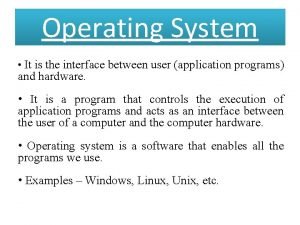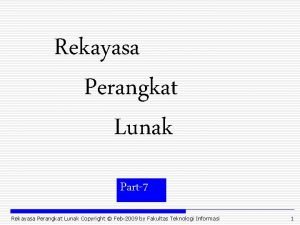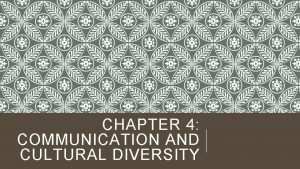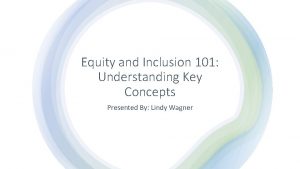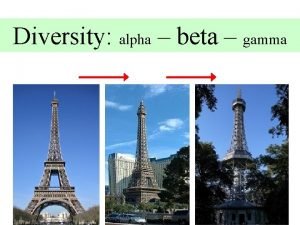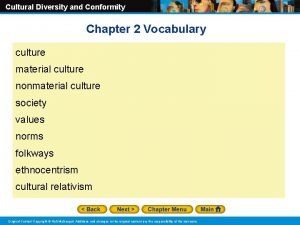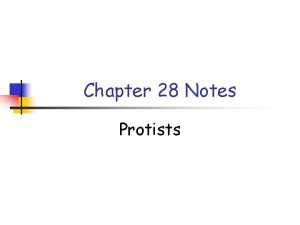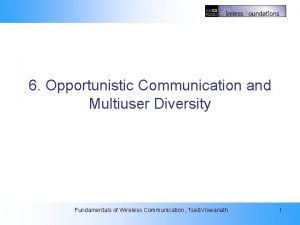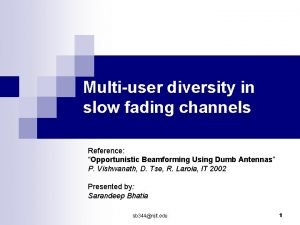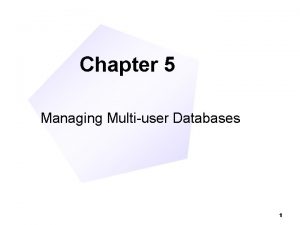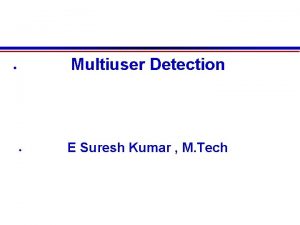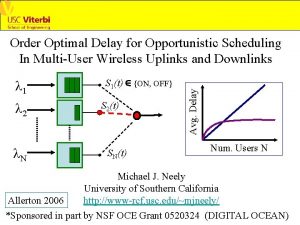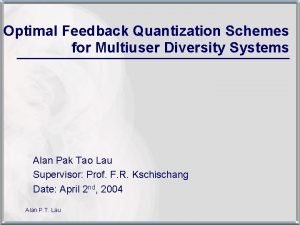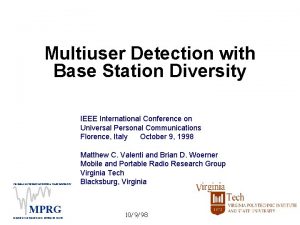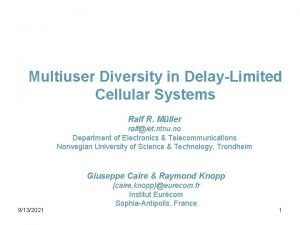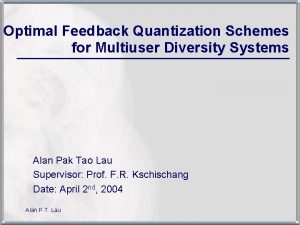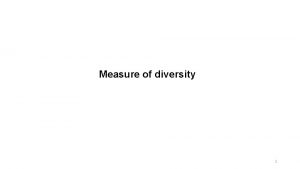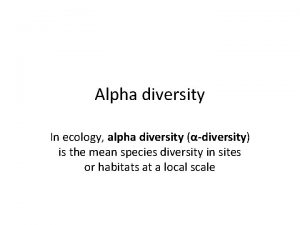6 Opportunistic Communication and Multiuser Diversity 6 Opportunistic

































- Slides: 33

6: Opportunistic Communication and Multiuser Diversity 6. Opportunistic Communication and Multiuser Diversity Fundamentals of Wireless Communication, Tse&Viswanath 1

6: Opportunistic Communication and Multiuser Diversity Fundamental Feature of Wireless Channels: Time Variation • multipath fading • large-scale channel variations • time-varying interference Fundamentals of Wireless Communication, Tse&Viswanath 2

6: Opportunistic Communication and Multiuser Diversity Traditional Approach to Wireless System Design Compensates for channel fluctuations. Fundamentals of Wireless Communication, Tse&Viswanath 3

6: Opportunistic Communication and Multiuser Diversity Example: CDMA Systems Two main compensating mechanisms: 1. Channel diversity: – frequency diversity via Rake combining – macro-diversity via soft handoff – transmit/receive antenna diversity 2. Interference management: – power control – interference averaging Fundamentals of Wireless Communication, Tse&Viswanath 4

6: Opportunistic Communication and Multiuser Diversity What Drives this Approach? Main application is voice, with very tight latency requirements. Needs a consistent channel. Fundamentals of Wireless Communication, Tse&Viswanath 5

6: Opportunistic Communication and Multiuser Diversity Opportunistic Communication: A Different View Transmit more when and where the channel is good. Exploits fading to achieve higher long-term throughput, but no guarantee that the "channel is always there". Appropriate for data with non-real-time latency requirements (file downloads, video streaming). Fundamentals of Wireless Communication, Tse&Viswanath 6

6: Opportunistic Communication and Multiuser Diversity Point-to-Point Fading Channels Capacity-achieving strategy is waterfilling over time. Fundamentals of Wireless Communication, Tse&Viswanath 7

6: Opportunistic Communication and Multiuser Diversity Performance over Rayleigh Channel Fundamentals of Wireless Communication, Tse&Viswanath 8

6: Opportunistic Communication and Multiuser Diversity Performance: Low SNR At low SNR, capacity can be greater when there is fading. Fundamentals of Wireless Communication, Tse&Viswanath 9

6: Opportunistic Communication and Multiuser Diversity Hitting the Peaks At low SNR, one can transmit only when the channel is at its peak. Primarily a power gain. In practice, hard to realize such gains due to difficulty in tracking the channel when transmitting so infrequently. Fundamentals of Wireless Communication, Tse&Viswanath 10

6: Opportunistic Communication and Multiuser Diversity Multiuser Opportunistic Communication Fundamentals of Wireless Communication, Tse&Viswanath 11

6: Opportunistic Communication and Multiuser Diversity Performance AWGN Increase in spectral efficiency with number of user at all SNR’s, not just low SNR. Fundamentals of Wireless Communication, Tse&Viswanath 12

6: Opportunistic Communication and Multiuser Diversity Total average SNR = 0 d. B. • In a large system with users fading independently, there is likely to be a user with a very good channel at any time. • Long term total throughput can be maximized by always serving the user with the strongest channel. Fundamentals of Wireless Communication, Tse&Viswanath 13

6: Opportunistic Communication and Multiuser Diversity: A More Insightful Look • Independent fading makes it likely that users peak at different times. • In a wideband system with many users, each user operates at low average SNR, effectively accessing the channel only when it is near its peak. • In the downlink, channel tracking can be done via a strong pilot amortized between all users. Fundamentals of Wireless Communication, Tse&Viswanath 14

6: Opportunistic Communication and Multiuser Diversity Application to 1 x EV-DO’s Down. Link • Multiuser diversity provides a system-wide benefit. • Challenge is to share the benefit among the users in a fair way. Fundamentals of Wireless Communication, Tse&Viswanath 15

6: Opportunistic Communication and Multiuser Diversity Symmetric Users Serving the best user at each time is also fair in terms of long term throughputs. Fundamentals of Wireless Communication, Tse&Viswanath 16

6: Opportunistic Communication and Multiuser Diversity Asymmetric Users: Hitting the Peaks Want to serve each user when it is at its peak. A peak should be defined with respect to the latency time-scale tc of the application. Fundamentals of Wireless Communication, Tse&Viswanath 17

6: Opportunistic Communication and Multiuser Diversity Proportional Fair Schedule the user with the highest ratio Rk = current requested rate of user k Tk = average thruput of user k in the past tc time slots. Fundamentals of Wireless Communication, Tse&Viswanath 18

6: Opportunistic Communication and Multiuser Diversity Performance Fixed environment: 2 Hz Rician fading with Efixed/Escattered =5. Low mobility environment: 3 km/hr, Rayleigh fading High mobility environment: 120 km/hr, Rayleigh fading Fundamentals of Wireless Communication, Tse&Viswanath 19

6: Opportunistic Communication and Multiuser Diversity Channel Dynamics Channel varies faster and has more dynamic range in mobile environments. Fundamentals of Wireless Communication, Tse&Viswanath 20

6: Opportunistic Communication and Multiuser Diversity Why No Gain with High Mobility? 3 km/hr 30 km/hr 120 km/hr Can only predict the average of the channel fluctuations, not the instantaneous values. Fundamentals of Wireless Communication, Tse&Viswanath 21

6: Opportunistic Communication and Multiuser Diversity Throughput of Scheduler: Asymmetric Users (Jalali, Padovani and Pankaj 2000) Fundamentals of Wireless Communication, Tse&Viswanath 22

6: Opportunistic Communication and Multiuser Diversity Inducing Randomness • Scheduling algorithm exploits the nature-given channel fluctuations by hitting the peaks. • If there are not enough fluctuations, why not purposely induce them? Fundamentals of Wireless Communication, Tse&Viswanath 23

6: Opportunistic Communication and Multiuser Diversity Dumb Antennas The information bearing signal at each of the transmit antenna is multiplied by a random complex gains. Fundamentals of Wireless Communication, Tse&Viswanath 24

6: Opportunistic Communication and Multiuser Diversity Slow Fading Environment: Before Fundamentals of Wireless Communication, Tse&Viswanath 25

6: Opportunistic Communication and Multiuser Diversity After Fundamentals of Wireless Communication, Tse&Viswanath 26

6: Opportunistic Communication and Multiuser Diversity Slow Fading: Opportunistic Beamforming • Dumb antennas create a beam in random time-varying direction. • In a large system, there is likely to be a user near the beam at any one time. • By transmitting to that user, close to true beamforming performance is achieved. Fundamentals of Wireless Communication, Tse&Viswanath 27

6: Opportunistic Communication and Multiuser Diversity Opportunistic Beamforming: Slow Fading Fundamentals of Wireless Communication, Tse&Viswanath 28

6: Opportunistic Communication and Multiuser Diversity Opportunistic Beamforming: Fast Fading Improves performance in fast fading Rician environments by spreading the fading distribution. Fundamentals of Wireless Communication, Tse&Viswanath 29

6: Opportunistic Communication and Multiuser Diversity Overall Performance Improvement Mobile environment: 3 km/hr, Rayleigh fading Fixed environment: 2 Hz Rician fading with Efixed/Escattered =5. Fundamentals of Wireless Communication, Tse&Viswanath 30

6: Opportunistic Communication and Multiuser Diversity Smart vs Dumb Antennas • Space-time codes improve reliability of point-to-point links but reduce multiuser diversity gain. • Dumb antennas add fluctuations to point-to-point links but increases multiuser diversity gains. Fundamentals of Wireless Communication, Tse&Viswanath 31

6: Opportunistic Communication and Multiuser Diversity Cellular System: Opportunistic Nulling • In a cellular systems, users are scheduled when their channel is strong and the interference from adjacent base-stations is weak. • Multiuser diversity allows interference avoidance. • Dumb antennas provides opportunistic nulling for users in other cells. • Particularly important in interference-limited systems with no soft handoff. Fundamentals of Wireless Communication, Tse&Viswanath 32

6: Opportunistic Communication and Multiuser Diversity Conventional vs Opportunistic Communication Fundamentals of Wireless Communication, Tse&Viswanath 33
 Gui is an interface between
Gui is an interface between Smartuml
Smartuml Multiuser operating system
Multiuser operating system Retroviruses and opportunistic infections
Retroviruses and opportunistic infections What is ecosystem biodiversity
What is ecosystem biodiversity Ecosystem jigsaw activity
Ecosystem jigsaw activity Opportunistic infections
Opportunistic infections Opportunistic infections
Opportunistic infections Opportunistic approach adalah model proses untuk
Opportunistic approach adalah model proses untuk Focused opportunistic approach
Focused opportunistic approach Chapter 4 communication and cultural diversity
Chapter 4 communication and cultural diversity Cultural diversity 3939 answers
Cultural diversity 3939 answers Diversity and human needs and development
Diversity and human needs and development What is oral communication and written communication
What is oral communication and written communication Definition of oral communication
Definition of oral communication Parallel communication examples
Parallel communication examples Conclusion for diversity
Conclusion for diversity Care certificate equality and diversity
Care certificate equality and diversity Nature nurture and human diversity
Nature nurture and human diversity Ecological diversity is a measure of the number of
Ecological diversity is a measure of the number of Diversity, equity and inclusion 101
Diversity, equity and inclusion 101 Diversity and inclusion scorecard
Diversity and inclusion scorecard Diversity and interdependence of life
Diversity and interdependence of life Alpha vs beta diversity
Alpha vs beta diversity Sunrise model of madeleine leininger’s theory
Sunrise model of madeleine leininger’s theory Cultural diversity vocabulary
Cultural diversity vocabulary Cultural diversity and conformity guided reading section 3
Cultural diversity and conformity guided reading section 3 Chapter 8 human resources culture and diversity
Chapter 8 human resources culture and diversity Chapter 8 human resources culture and diversity
Chapter 8 human resources culture and diversity Biological diversity and conservation chapter 5 answers
Biological diversity and conservation chapter 5 answers Diversity and regulatory challenges
Diversity and regulatory challenges Structural and functional diversity in protists
Structural and functional diversity in protists Chapter 17 section 1 the history of classification
Chapter 17 section 1 the history of classification Equality and diversity care certificate
Equality and diversity care certificate
